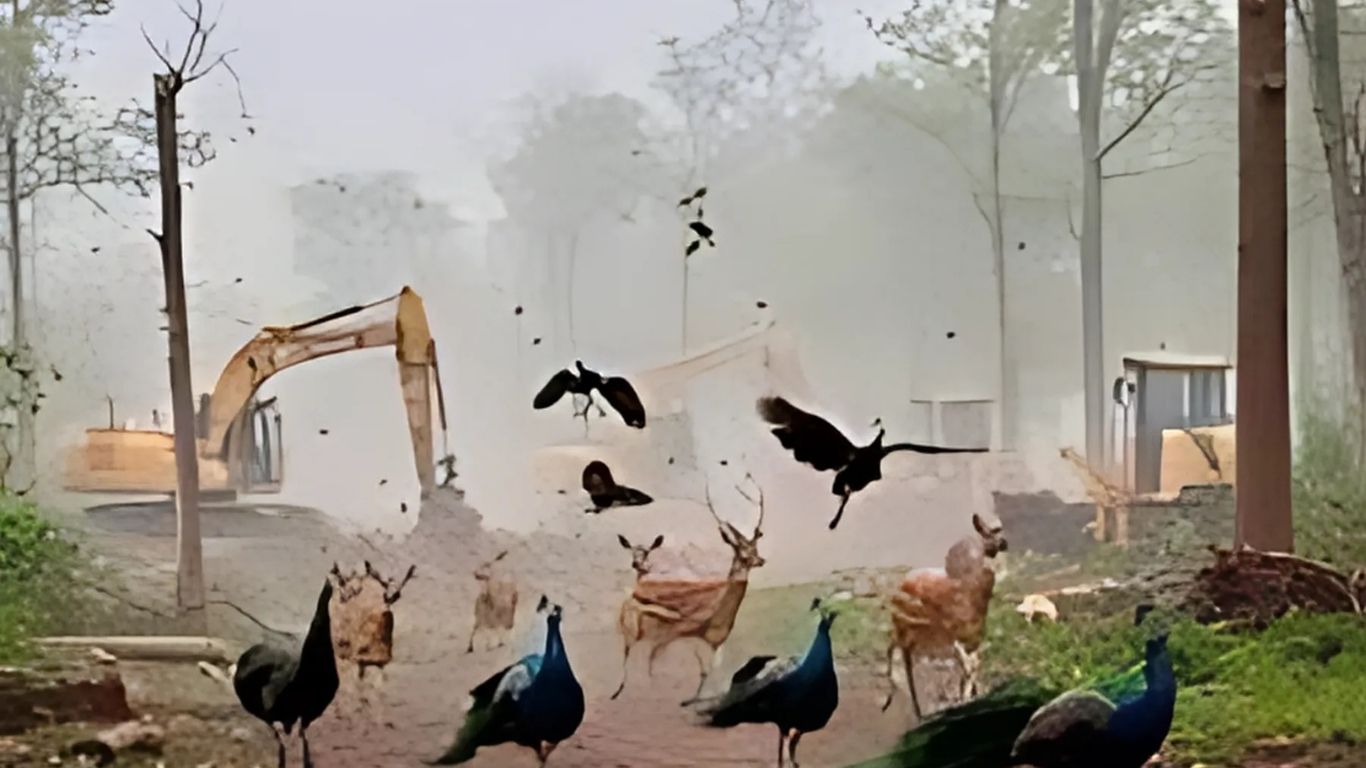The Silent Scream of Telangana Wildlife is losing one of its final green lungs, and the effects could be catastrophic. An astounding 400 acres of forest area in Kancha Gachibowli are being levelled to give way to asphalt and concrete. For the animals that inhabited it, this translates to annihilation. For the residents, this translates to soaring temperatures, disappearing groundwater, and an increasingly more oppressive urban heat island effect. And yet, in spite of the warning bells, the demolitions persist.
Table of Contents
A State Once Rich in Greenery
The Silent Screams of Telangana Wildlife has a complex relationship with its forests. Official figures suggest that 27,292 sq. km of the state—about 24.35% of its land—falls under forest cover. But how much of this is actual forest, with thriving ecosystems, towering trees, and diverse wildlife? That remains an unanswered question.
Forests had covered Telangana, especially the Godavari basin, where teak forests grew thick. But in the years since the state was constituted in 2014, urbanization, irrigation schemes, and road building have eaten into these forests. The consequence? Increasingly unpredictable monsoons, frequent flooding, and water scarcity are read as signs of ecological disturbance.
Also read: Ultraviolette Shockwave India’s First Dual Electric Motorcycle
The government recognizes the crisis, at least on paper. In March 2024, it made a promise to expand Telangana’s forest cover from 24.05% to 33%, as per the National Forest Policy of 1988. But promises need to be fulfilled. In order to meet this goal, Telangana would have to add 10,000 sq. km more of forest. But instead of protecting what we already have, we are seeing large-scale clearing of green areas like Kancha Gachibowli.
The Myth of Afforestation: Failures of Haritha Haram
A few years ago, in 2015, the Telangana government initiated the grand Haritha Haram program with a vow to plant 230 crore saplings. By 2019, around 177 crore had reportedly been planted, but an enormous number of them did not survive. What we actually required was forest rehabilitation—repaving lost habitats—and not the planting of saplings on the roadside.
A forest is not a collection of trees; it’s an ecosystem of biodiversity. Forests take centuries to mature as self-balancing habitats for flora and fauna. Tree plantation is a beginning, but without the guarantee of their survival and their inclusion in a living ecosystem, it is an unsuccessful endeavor. The clearance of forests like Kancha Gachibowli, even with such afforestation practices, proves this harsh fact.
Why Kancha Gachibowli Matters
The Silent Screams of Telangana Wildlife On the surface, 400 acres may not sound like much, but Kancha Gachibowli is not just another piece of land—it’s a biodiversity hotspot. Supporting numerous species, this land is an integral part of the Musi river basin and is vital in terms of groundwater recharge. As of March 2025, the groundwater potential here is 15.62 meters. Compare that with the 10.8 meters measured in the surrounding areas that are already weighed down by skyscrapers. It’s apparent that this ground serves as a water sink, avoiding excess runoff and refilling underground stores.
Also read: Uttar Pradesh UP GNM Entrance Test UPGET 2025: Admissions
The soil also acts as a natural flood buffer. Removing it for development results in heavier monsoon floods and more severe summer droughts. Once 400 acres are covered with glass towers and highways, the microclimate of the area will be affected. The temperature will rise by as much as 4°C, exacerbating Hyderabad’s urban heat emergency.
A Forest in Legal Limbo
It can be argued that the land is on sale and belongs to different claimants. But ownership should not be the issue—the purpose of the land should be. The Supreme Court’s 1996 judgment in the TN Godavarman Thirumulpad case broadened the definition of ‘forests‘ beyond legal definitions. Any land with high tree cover and ecological value is a ‘deemed forest’ and should be accorded the same protection as officially declared forests.
By this definition, Kancha Gachibowli fits the bill. The government of Telangana itself recently constituted a committee to demarcate forest lands and compile land records. If done in good faith, Kancha Gachibowli must be declared as a forest and protected from commercial encroachment.
The Master Plan’s Blind Spot
Hyderabad’s urban growth is controlled by the Hyderabad Metropolitan Development Authority (HMDA), which governs 7,235 sq. km under a master plan. The 2023 iteration of this plan, however, falls far short. Although some regions are designated as ‘conservation zones,’ most of these areas are quietly rezoned for residential and commercial development. Worse, there is no specified objective to ensure that 33% of HMDA land is still forested.
If Hyderabad is to continue with its expanding population without buckling under ecological pressure, it requires green spaces—more than for beautification, but for survival. The loss of Kancha Gachibowli, rather than its restoration and conservation, is a stark failure of urban planning.
The Way Forward: Conservation Over Exploitation
Instead of going further down this road of devastation, the government of Telangana must redirect its attention from simple afforestation to real conservation. Here’s how:
Cancel the auction and make Kancha Gachibowli a protected forest. The land qualifies as a ‘deemed forest’ and must be dealt with accordingly.
Revise the HMDA master plan. Any revised version of the plan should have green spaces as the top priority and implement tough regulations for avoiding deforestation within city boundaries.
Enhance afforestation plans. Rather than planting trees in quantity, pay attention to re-establishing ecosystems and tree survival.
Enforce water conservation at the groundwater level. With an accelerated decline through unbridled urban growth, Hyderabad requires enhanced regulations for groundwater usage and better rainwater harvesting policies.
Public awareness and participation. Hyderabadis need to be informed of what is at risk. Public campaigns, judicial interventions, and activism can exert pressure on authorities to save the city’s green cover.
A Fight We Cannot Afford to Lose
Telangana is at a crossroads. It can either continue prioritizing short-term commercial gains or recognize the irreplaceable value of its natural ecosystems. If the state genuinely wants to achieve 33% forest cover, it must first protect what it already has.
The devastation of Kancha Gachibowli isn’t about Hyderabad losing some trees—it’s about the city losing its fight against climate change, water shortages, and biodiversity decline. The howls of wildlife pushed out by bulldozers won’t be heard by all, but this loss will be suffered by all.






